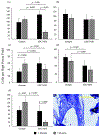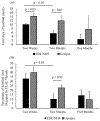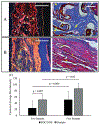In vivo biocompatibility and time-dependent changes in mechanical properties of woven collagen meshes: A comparison to xenograft and synthetic mid-urethral sling materials
- PMID: 29897162
- PMCID: PMC7335430
- DOI: 10.1002/jbm.b.34138
In vivo biocompatibility and time-dependent changes in mechanical properties of woven collagen meshes: A comparison to xenograft and synthetic mid-urethral sling materials
Abstract
Meshes woven from highly aligned collagen threads crosslinked using either genipin or 1-ethyl-3-(3-dimethylaminopropyl) carboiimide and N-hydroxy succinimide (EDC/NHS) were implanted in a subcutaneous rat model to evaluate their biocompatibility (at 2 weeks, 2 months, and 5 months), mechanical properties (at baseline, 2 months, and 5 months) and ultimately their suitability for use as mid-urethral slings (MUS) for management of stress urinary incontinence. Porcine dermal (Xenmatrix) and monofilament polypropylene (Prolene) meshes were also implanted to provide comparison to clinically used materials. Quantitative histological scoring showed tissue integration in Xenmatrix was almost absent, while the open network of woven collagen and Prolene meshes allowed for cellular and tissue integration. However, strength and stiffness of genipin-crosslinked collagen (GCC), Prolene, and Xenmatrix meshes were not significantly different from those of native rectus fascia and vaginal tissues of animals at 5 months. EDC/NHS-crosslinked collagen (ECC) meshes were degraded so extensively at five months that samples could only be used for histological staining. Picrosirius red and Masson's trichrome staining revealed that integrated tissue within GCC meshes was more aligned (p = 0.02) and appeared more concentrated than ECC meshes at 5 months. Furthermore, immunohistochemical staining showed that GCC meshes attracted a greater number of cells expressing markers for M2 macrophages, those associated with regeneration, than ECC meshes (p = 0.01 for CD206+ cells, p = 0.001 CD163+ cells) at 5 months. As such, GCC meshes hold promise as a new MUS biomaterial based on favorable induction of fibrous tissue resulting in mechanical stiffness matching that of native tissue. © 2018 Wiley Periodicals, Inc. J Biomed Mater Res Part B: Appl Biomater, 2018. © 2018 Wiley Periodicals, Inc. J Biomed Mater Res Part B: Appl Biomater 107B: 479-489, 2019.
Keywords: collagen; stress urinary incontinence; tissue engineering.
© 2018 Wiley Periodicals, Inc.
Figures








References
-
- Gandhi S, Kubba LM, Abramov Y, Botros SM, Goldberg RP, Victor TA, Sand PK. Histopathologic changes of porcine dermis xenografts for transvaginal suburethral slings. Am J Obstet Gynecol 2005;192:1643–1648. - PubMed
-
- Khan ZA, Nambiar A, Morley R, Chapple CR, Emery SJ, Lucas MG. Long-term follow-up of a multicentre randomised controlled trial comparing tension-free vaginal tape, xenograft and autologous fascial slings for the treatment of stress urinary incontinence in women. BJU Int 2015;115:968–977. - PubMed
-
- Nilsson C, Palva K, Aarnio R, Morcos E, Falconer C. Seventeen years’ follow-up of the tension-free vaginal tape procedure for female stress urinary incontinence. Int Urogynecol J 2013;24: 1265–1269. - PubMed
MeSH terms
Substances
Grants and funding
LinkOut - more resources
Full Text Sources
Other Literature Sources
Research Materials

